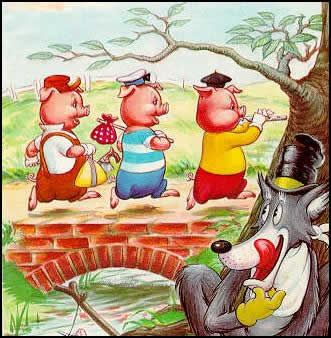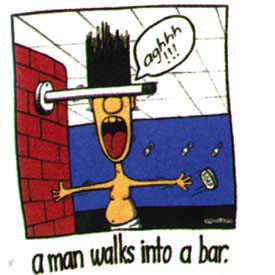My first link to a video
I’m finding so much good material out there about language, it’s tempting to spend too much time merely sharing links. I have to discipline myself to include my own material sometimes. I was disciplined last post, and I will be again the post after next. Meanwhile, here’s a pretty good link to share.
This video is of comedian John Branyan telling the story of the three little pigs in the elevated and erudite language of a couple centuries ago. By the way, Shakespeare spoke Elizabethan English, not Old English. Click here to see it: Three Little Pigs.
Subscribe to this blog's RSS feed
Professionalisms
Many times you have a choice of what words or phrases to use when you write. Both (or more) of your choices are grammatical—more than one choice would be grammatically correct—but one choice is better than the others. I have noticed a few items that professionals consistently get right, and amateurs frequently get wrong.
That said is better than that being said. Why? Because whatever thing you’re referring to is over with, so the simple past is correct. Literally, the second choice tells you that it’s still being said, which is not true. Here’s an example from that book about anthrozoology I mentioned in the last post:
As a result, Koreans are increasingly ambivalent about eating dogs, and a recent poll found that 55% of adults disapproved of eating canine flesh. That said, the same survey reported that fewer than 25% of South Koreans favor a ban on dogmeat.
That first sentence is clearly in the past, and over with. So “that said” is better.
More than is better than over. When you compare numbers, strictly speaking, you are comparing more with fewer, not higher with lower. This metaphor can be ironic when the numbers go down. For example, if you’re in a submarine at over 600 feet, are you at 599 or 601?
After or when are better than once. This item appears when you have two or more events that happen one after the other. Think about it. What does “once” mean? One time.
After the griddle is hot enough, pour on the batter. When you get your shoes on, you may go outside. Once is enough, young man!
Speaking of putting things in order, don’t say “on top of each other.” This is literally impossible. It’s one on top of another.
Don’t use virtually for almost. “Virtually” is a perfectly good word, but it means “not real;” it doesn’t mean “almost.”
Almost everyone in the room was a grammar nazi. The mime was trapped inside a virtual wall.
There’s a fine pair of sentences, even if the first one describes an unlikely circumstance.
A final example of professionalism: Professionals don’t overuse “as well as.” Most of the time they use plain old “and.” “As well as” implies some kind of separation between the two items. “And” joins them.
A good friend of mine, Jack Riepe, writes a very funny blog called Twisted Roads. However, he is an outstanding public relations writer as well as a humorist.
The separation implied here is that you might not expect both skills to reside in the same person. However, in a bio on the back cover of a book you might find a sentence like this:
Jack Riepe is a public relations writer and humorist who lives in Cape May, NJ.
Here the two go together like chocolate and ice cream. Take a look at the blog; it is pretty funny.
Getting verbs right part 3
This lesson is also about technical writing, but it applies to expository writing in general. It has to do with how you shouldn’t use the future tense.
Rule: Don’t use the future tense unless you really, really have to. Use the present instead.
The present tense has a, shall we say “flexible” connection with time. The standard use is to describe what’s going on right now, in the present. The present tense has (at least) two other uses, though. It can describe the past by placing the reader into that past event.
So a minister, a priest, and a rabbi walk into a bar. The bartender looks up and says, “What is this, some kind of a joke?”
A horse walks into a bar. The bartender says, “Why the long face?”
That’s the present tense: (They) walk. The bartender looks.
The other use of the present is to describe customary behavior. If something always happens that way, use the present, not the future. In the context of giving directions, you tell your reader what to do (use the imperative), then tell what happens if they do it right. Notice I just wrote “what happens,” not “what will happen.”
Open the File menu and click Save as. The Save As dialog box appears.
Tighten all six bolts to 24 foot-pounds to prevent gas from escaping.
So when may you use the future tense? When you want to be vague. When something is not customary. When something might not happen.
Climb down from that tree or you will break your neck!
One of these days I’m going to stop procrastinating.
But when you’re explaining something, use the present.
Metaphor in technical writing
In the most general sense, a figure of speech is when you do something artistic with your writing. You’re probably familiar with alliteration and onomatopoeia, but how about synecdoche? (Look it up. You use it.)
I generally recommend a writing style that doesn’t call attention to the writing itself, so conspicuous figures of speech are generally not a good idea. The less technical your writing is, the more you can get away with using figures of speech. They add color and interest to the writing; make it a little more fun to read.
Metaphor is a figure of speech that compares two things by saying that one thing is the other. A post a while back contained a lot of metaphors. You learn about metaphor in grade school, usually with its cousin, the simile, which compares to things by saying that one thing is like the other. (“My love is like a red, red rose…”)
Normally you won’t find it a good idea to use metaphors in technical writing. You should stick to the literal truth, the plain facts. Metaphors can confuse the issue but bringing in extraneous concepts. Recently I read a book that was on a technical subject, but it was addressed to a lay readership, and the introduction was the perfect place for the author to use a couple of metaphors to make his description of his subject more vivid. The book is about anthrozoology, the study of how humans relate with animals. The title of the book is Some we Love, Some we Hate, and Some we Eat. It’s a pretty interesting read, and you can click the link to go to Amazon to get it. Here are the metaphors:
“How much money are you giving out?” I ask. Two and a half million dollars a year, she says. “Fantastic! This is just what the field needs,” I say. I am thinking that Layla is going to have a very full dance card for the next couple of days.
Anthrozoology is a big tent. It includes the study of nearly all aspects of out interactions with other species.
As academic disciplines go, anthrozoology is a small pond, but in the last two decades, we have come a long way.
Those quotes contain four metaphors. Can you find them all? The fourth one is so common you might not notice it.
I try to find an excuse to put up pictures, so here’s what the cover looks like:
A little evangelism
The number of people who look at this site has skyrocketed since I began mentioning it on Google+. At least three people a day now! One of my most loyal readers, Ann Marie Dwyer, has a blog called Momma’s Money Matters. It covers a wide variety of topics, articulately written, and it includes interviews of writers. I am pleased to say that hers is one of few sites on which I have not yet seen a typo. Not only that, but she has a page inviting her readers to plug their own blogs. I suggest you poke around the site and maybe become a reader. Here’s the page:
Take a look, and tell her I sent you.
Next post: back to grammar unless something else comes up.




